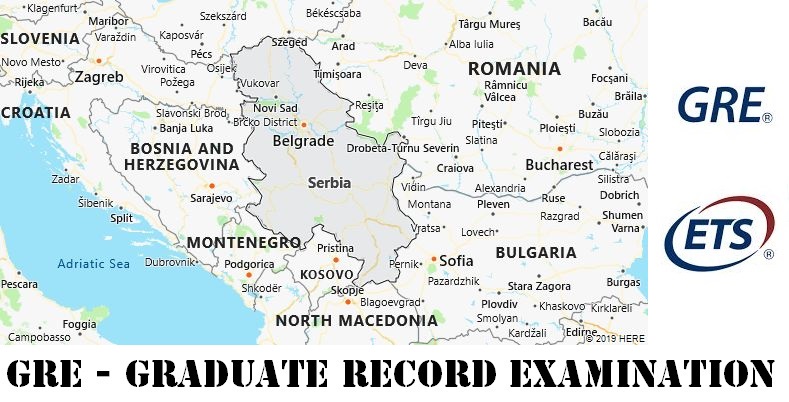GRE Testing Locations
Decided to take GRE exam? Now it is time to determine where to take the test. This site provides a full list of GRE testing centers in Serbia, among which, you can choose one that is nearest to you. Good news is that the following GRE test locations in Serbia offer both GRE general test and the GRE subject tests.

- BELGRADE, SERBIA – APCU-8079
International Academic Center, Third Floor, Zdravka Celara 12, Belgrade
Serbia 11000
Computer Based Test
GRE Test Dates
There are two types of test format offered by the test maker – ETS: Computer-delivered and Paper-delivered GRE general tests. For computer based test format, the GRE General Test is offered year-round on a continuous basis, and available for registration on a first-come, first-served basis. For paper based general test, testing is available three times per year. The following test dates apply:
| Test Dates for Paper Based | Deadlines for Registration | Scores Available |
|---|---|---|
| November 09, 2019 | October 4, 2019 | December 20, 2019 |
| February 1, 2020 | December 27, 2019 | March 13, 2020 |
GRE Subject Tests in Serbia
The GRE Subject Tests are available on paper based only. In all GRE test centers throughout the world (both inside and outside United States), the exam is available three times a year. The three test dates are:
- April
- September
- October

More about Serbia
Serbia and Montenegro, former confederation in Southeast Europe, on February 4, 2003 as successor state to the Federal Republic Yugoslavia emerged, was according to the constitution a federation (loose union of states) of the two largely independent states Serbia and Montenegro. In a referendum on May 21, 2006, those in favor of dissolving the union of states with Serbia prevailed in Montenegro. On June 5, 2006, the Serbian parliament also declared the state union ended, and Serbia took over as legal successor.
Serbia borders in the north on Hungary, in the east on Romania and Bulgaria, in the south on the Republic of North Macedonia and Kosovo, in the south-west on Montenegro, in the west on Bosnia and Herzegovina and Croatia.
In the north, in Vojvodina, with the regions of Batschka, Sirmia and the western Banat, Serbia has a share of the Great Hungarian Lowlands, in which there are isolated hill and mountainous lands (including Fruška Gora). To the south of the rivers Danube and Sava, which flow through the lowlands, there is a wooded mountainous area with Šumadija, south of Belgrade, to the south-west of it and east and south of the Great Morava and the Western Morava, respectively, higher mountains extend: in the south-west the massifs of Povlen and Suvobor (over 1,200 m above sea level), in the east the Serbian Ore Mountains (over 1,300 m above sea level) and east of the Timok the Western Balkans (over 2,100 m above sea level) and south of the Western Morava the Kopaonik Mountains (up to 2,016 m above sea level). The highest point is on the border with Bulgaria (Midžor in the Western Balkans, 2 169 m above sea level). The mountain area is crossed by the valley of the Morava and its largest source river, the Southern Morava, in a south-north direction (part of the Morava-Vardar furrow). This valley forms an important traffic and settlement axis.
Climate and vegetation
The inland is characterized by a temperate continental climate and has Mediterranean features in the south. The January mean temperature fluctuates between 0 and -3 ° C, the July means are around 20 ° C. The precipitation (maximum in June) in Vojvodina is between 500 and 700 mm annually and increases in the mountainous countries in the east up to 1 000 mm. – The northern part of Serbia belongs to the Pannonian vegetation area, for which soft-haired oaks, sweet chestnuts, hornbeams and hopsbeams are characteristic as natural vegetation, in the south and south-westerly direction forms of the Illyrian zone are increasing. Characteristic is v. a. the Šibeljak formation, a thorny thicket, adapted to the drought, especially on the lower slopes of the mountains and in the mountainous countries. National parks are located in the hill country of the Fruška Gora in Sirmia, at the Danube breakthrough through the Carpathian Mountains (Iron Gate) and in the Kopaonik Mountains.
Population
Around 83% of the population are Serbs, 4% Hungarians (especially in Vojvodina) and 2% Bosniaks (especially in Sanjak). The remaining 11% are made up of numerous other minorities (including Montenegrins, Croats, Albanians, Slovaks). According to an estimate, the number of Roma is around 135,000. The minority of Germans comprised around 4,100 people in 2011 (especially in Vojvodina). As a result of the Yugoslav civil wars, there were changes in the spatial distribution of the various ethnic groups, numerous non-Serbs fled to neighboring countries, Serbian refugees and displaced persons came from Croatia (Krajina Serbs) and Kosovo as well as from Bosnia and Herzegovina. The population density is on average 80 people / km 2(2017); 56% live in cities.
The biggest cities in Serbia
| Biggest Cities (Residents 2011) | |
| Belgrade | 1 690 200 *) |
| Novi Sad | 231 800 |
| Niš | 183 200 |
| Kragujevac | 150 800 |
| Subotica | 97 900 |
| *) 2018 | |
